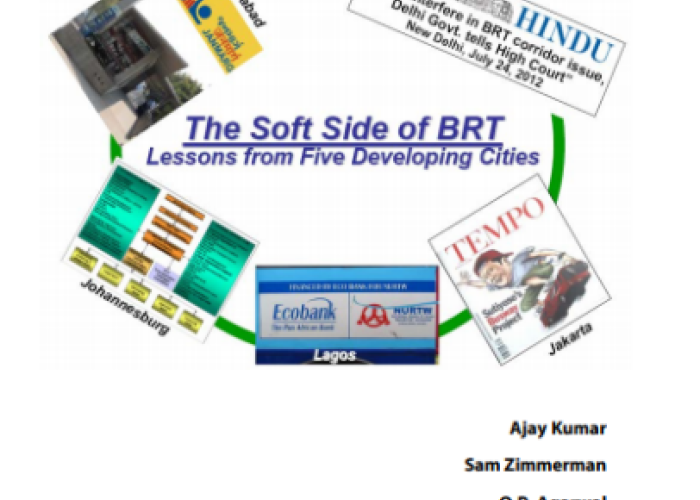The Soft Side of BRT - World Bank

The Soft Side of BRT: Lessons from Five Developing Cities Lagos Johannesburg Jakarta Ahmedabad Delhi World Bank
- SUMP
- Mass Public Transport
Reports & Case Studies
CHEVRE Antoine
Transport Team Leader
ELECTRIC MOBILITY: DEVELOPMENTS IN LATIN AMERICA AND THE CARIBBEAN AND OPPORTUNITIES FOR REGIONAL COLLABORATION - Euroclima + Aecid
Electric mobility is growing exponentially across the world. Latin America and the Caribbean is no exception. While this region is not on the forefront of this technology transition, there are already significant accomplishments. For example, this year, Colombia broke the record with more than a thousand electric vehicles in circulation – the highest figure in the region so far. Chile presented a new tender for Transantiago (Santiago bus operator), which raises a new model of contractual structure for the massive incorporation of electric buses in its public transport system [5]. Bogota, Loja, Santiago, Mexico City, as well as several other cities Brazil, already have electric taxi fleets. Uruguay, Brazil and Mexico installed fast charging interprovincial corridors for electric vehicles. Costa Rica approved the first comprehensive national law for the promotion and incentive of electric transport in 2017 [6]. Furthermore, during the International Motor Show in Sao Paulo, different civil entities from the region formed the Latin American Association of Sustainable Mobility (ALAMOS, given its acronym in Spanish), with the aim of promoting electric mobility at a regional level [7]. These are just a few of the developments related to electric mobility in the region, so far unprecedented. The question ahead is no longer whether electric mobility will reach a large scale in Latin America and the Caribbean, rather when.
In the framework of the XXI Meeting of the Forum of Ministers of Environment of Latin America and the Caribbean, held in October 2018, in Buenos Aires, Argentina, Costa Rica presented a proposal for a “Dialogue on Electric Mobility”, which was supported by Argentina, Barbados, Belize, Bolivia, Chile, Colombia, El Salvador, Grenada, Guatemala, Honduras, Mexico, St. Lucia and Uruguay. This dialogue aims to promote joint learning in regard to strategies and regulatory frameworks for electric mobility, development of financial instruments and new business models, facilitate capacity-building and knowledge-sharing, promote joint-collaboration in pilot projects, as well as to explore synergies and opportunities with other fields of knowledge, with emphasis on innovation and the creation of new jobs.
The current analysis builds on the basis of a previous study published by UN environment and the Mario Molina Chile Center in 2016, through the MOVE platform, titled "Electric Mobility: Opportunities for Latin America” [8]. Our previous report characterized the status of transport systems in the region, and identified the main barriers and drivers influencing the development of electric mobility. The current report aims to provide an update on the main events and achievements in the region related to electric mobility and to present the basis for discussion on the regional agenda in this area, over the coming years. It is worth emphasizing that many of these regional developments were difficult to glimpse just two years ago when the first report was published.
In the following sections, the background for electric mobility in the region is presented, followed by a general description of the current state and of the development of electric mobility in several leading countries of Latin America and Caribbean. The document ends with conclusions and recommendations for regional collaboration related to electric mobility.